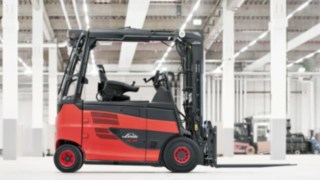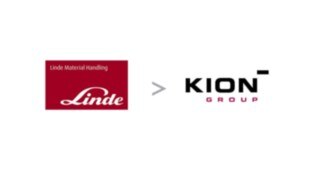
Revolution meets evolution
8 Jan 2019
World premiere for Linde Roadster with fuel cell drive
With its Roadster concept, Linde Material Handling has set completely new standards in terms of visibility and safety for industrial trucks. The company is now adding one of the most promising energy systems to the advantages of this unique design: It’s curtain up for the first Linde Roadster with fuel cell drive!
It is one of the crucial questions in goods handling: Which drive technology is best suited for the operating conditions of a particular forklift fleet? To find the answer, fleet managers have to take a wide range of factors into account: Are the trucks meant to be used indoors or outdoors, will they operate in single or multi-shift systems, what kind of goods have to be moved, what is the local infrastructure like – and finally, what type of drive is recommendable in terms of total cost of ownership? “Our customers are looking for economical energy solutions and more and more often the CO2 footprint is playing a decisive role in this context,” says Markus Weinberger, International Product Manager Energy Solutions at Linde Material Handling: “Our sales consultants can offer them a wide range of possible energy solutions, from electric drives with lead-acid or lithium-ion batteries to fuel cell powered vehicles or combustion engine drives using diesel, LPG or natural gas. The best solution always depends on the local conditions.”
For two decades now, Linde Material Handling has been working on the development of series-production industrial trucks with fuel cells. “In 1997, we were ahead of the game, focusing intensively on this promising technology, and production of the first trucks started in 2010,” says Weinberger. “Today, the Linde brand offers the largest range of fuel cell-powered industrial trucks on the market. Around 80 percent of our models can be ordered with this promising energy option. These include pallet trucks, tow tractors and reach trucks as well as counterbalanced trucks including the Roadster model.”
A smart combination
With the Linde-Roadster, an extraordinary forklift meets an extraordinary drive concept: Thanks to its sophisticated vehicle layout, it provides optimum load and driving visibility. The absence of the usual A-pillar makes a significant contribution in this regard. This could be dispensed with thanks to overhead tilt cylinders that absorb the lifting forces and direct them backwards via the overhead guard frame. The Roadster versions of electric forklift trucks Linde E20 to E35 score particularly well in logistics and industrial facilities with heavy passenger traffic. In addition, the driver can carry out precision work such as container loading more easily thanks to the significantly larger field of vision.

Extraordinary forklift meets an extraordinary drive concept: the Linde-Roadster with fuel cell drive.
“As the strengths of the Roadster come to bear especially in indoor areas, its combination with fuel cell technology seemed ideal to us,” says Linde expert Weinberger, explaining the expansion of the portfolio. After all, the energy system does not generate any harmful emissions during operation. Energy production is through a chemical reaction between oxygen and hydrogen. The electricity generated in this way feeds a lithium-ion battery, which in turn supplies the traction and lift motors; at the same time, the accumulator serves as an intermediate storage for recovered braking energy and as a “power reserve” for peak periods of demand. The only by-products during the process are heat and pure water. The latter is pumped off during hydrogen refueling.
Speaking of refueling: This is where fuel cell technology reveals its greatest strength: A complete filling process takes a mere three minutes. This ensures maximum availability – especially in tough multi-shift operation, where the energy system makes a convincing case with its continuous power output. Since the simple, fast and clean filling process makes battery replacement obsolete, the fuel cell Roadster is ideal for use even in hygiene-critical sectors such as the pharmaceutical and food industries.
Of course, the factor of economic efficiency plays a decisive role too. Linde expert Markus Weinberger: “Our investigations and practical tests prove that fuel cell systems can become economical with a fleet of around 20 vehicles plus. If the company already has its own hydrogen infrastructure because hydrogen is needed in its production anyway, the concept becomes even more attractive from an economical point of view.” In addition, there is a whole range of ecological benefits, starting with the comparatively long service life of a fuel cell – around 10,000 operating hours – and extending to CO2 savings if the hydrogen used comes from regenerative sources such as biogas or electrolysis using solar and/or wind energy.

